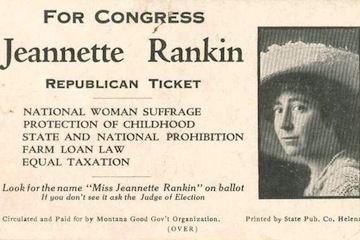Jeanette Rankin, First Woman in Congress
Jeanette Rankin was the first woman elected to Congress in the United States, winning an at-large seat in Montana in 1916. An outspoken suffragist and a Republican, she was immediately the focus of much praise and much criticism. When she voted against entry into World War I this focus became magnified. When she voted against entry into World War II, her political career was effectively over. However, her name was rehabilitated in pacifist circles towards the end of her life, and she has remained a feminist icon.
The idea to run for Congress came to Rankin from her work as a suffragist. She was a member of the National American Woman Suffrage Association (NAWSA), and had helped that organization win its women's suffrage campaigns in Washington and Montana. In the early 1900s, with a national Amendment out of reach, suffragists focused on a state-by-state campaign that won many victories in the West. As a resident of Montana, Rankin was in good position to contemplate her own political career, compared to women in other regions of the country.
With her experience in NAWSA, Rankin had a very good reputation in suffragist circles. Within Montana she had the financing and backing of her brother, who was well-connected to state politics. Rankin won a GOP nomination and ran as a progressive Republican, making no secret of her pacifist stance towards possible entry in World War I. She finished in second-place among several candidates for two at-large seats, and thereby set a monumental precedent for women in politics.
Rankin stuck to her word in regards to World War I. She was sworn into Congress on April 2, 1917, and on April 5 was called to vote on a declaration of war. She was one of 50 people in the House to vote against participation, and as a woman she was singled out for much criticism by the press, and by some suffragists who feared the negative attention. She also found herself on the wrong side of Montana's mining interests after a strike in that state, and for the 1918 election the districts were changed such that she would have needed to run in an overwhelmingly Democratic part of the state. Instead, she joined the Senate race, losing a primary and running as a third party candidate. In such a fashion, her first term in Congress ended and she returned to private life.
Rankin returned to Congress in 1940, first unseating the incumbent in a Republican primary election, and then defeating a former Congressman in the general election. By this time she enjoyed the support of prominent progressive Republicans nationwide, such as Robert LaFollete and Fiorello La Guardia. It was during her second term in the House that Japan attacked Pearl Harbor. In the ensuing vote, Rankin was on the losing end of a 388-1 vote, and became infamous in the press of the time. Knowing that she faced no chance of reelection, she declined to run in 1942.
Jeanette Rankin was also, as she put it, "... the only woman who ever voted to give women the right to vote." This occurred in 1918, during her first term in the House. She opened debate on a Constitutional Amendment to give all women the right to vote, and voted for its passage in the House. On this particular attempt, the Amendment was defeated in the Senate. However, one year later, it would be introduced again, and ultimately became ratified as the Nineteenth Amendment.
Rankin also said about herself, "I may be the first woman member of Congress, but I won't be the last." This was true, but perhaps not to the extent that Rankin would have hoped. Nearly 100 years after she was first elected, through the 2015-17 term, Congress has never had more than 104 female members. This represents 19.4% of that body's membership. Perhaps the next 100 years will see much bigger changes.
